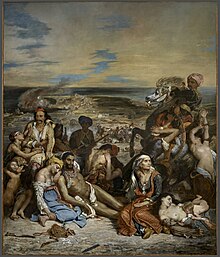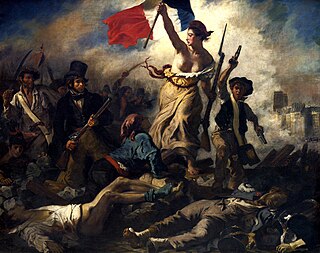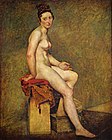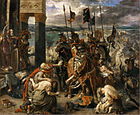Eugène Delacroix
From Wikipedia, the free encyclopedia
| Eugène Delacroix | |
|---|---|

Eugène Delacroix (portrait by Nadar)
|
|
| Birth name | Ferdinand Victor Eugène Delacroix |
| Born | 26 April 1798 Charenton-Saint-Maurice, Île-de-France, France |
| Died | 13 August 1863 (aged 65) Paris, France |
| Nationality | French |
| Field | Painting, Lithography |
| Movement | Romanticism |
| Works | Liberty Leading the People, 1830 |
In contrast to the Neoclassical perfectionism of his chief rival Ingres, Delacroix took for his inspiration the art of Rubens and painters of the Venetian Renaissance, with an attendant emphasis on colour and movement rather than clarity of outline and carefully modelled form. Dramatic and romantic content characterized the central themes of his maturity, and led him not to the classical models of Greek and Roman art, but to travel in North Africa, in search of the exotic.[2] Friend and spiritual heir to Théodore Géricault, Delacroix was also inspired by Lord Byron, with whom he shared a strong identification with the "forces of the sublime", of nature in often violent action.[3]
However, Delacroix was given to neither sentimentality nor bombast, and his Romanticism was that of an individualist. In the words of Baudelaire, "Delacroix was passionately in love with passion, but coldly determined to express passion as clearly as possible."[4]
Contents
Early life
Eugène Delacroix was born on 26 April 1798 at Charenton-Saint-Maurice in Île-de-France, near Paris. His mother was named Victoire, daughter of the cabinet-maker Jean-François Oeben. He had three much older siblings. Charles-Henri Delacroix (1779–1845) rose to the rank of General in the Napoleonic army. Henriette (1780–1827) married the diplomat Raymond de Verninac Saint-Maur (1762–1822). Henri was born six years later. He was killed at the Battle of Friedland on 14 June 1807.[5]There is reason to believe that Eugène's father, Charles-François Delacroix, was infertile at the time of Eugène's conception and that his real father was Talleyrand, who was a friend of the family and successor of Charles Delacroix as Minister of Foreign Affairs, and whom the adult Eugène resembled in appearance and character.[6] Throughout his career as a painter, he was protected by Talleyrand, who served successively the Restoration and king Louis-Philippe, and ultimately as ambassador of France in Great Britain, and later by Talleyrand's grandson, Charles Auguste Louis Joseph, duc de Morny, half-brother of Napoleon III and speaker of the French House of Commons. His presumed father, Charles Delacroix, died in 1805, and his mother in 1814, leaving 16-year-old Eugène an orphan.
His early education was at the Lycée Louis-le-Grand, and at the Lycée Pierre Corneille in Rouen[7] where he steeped himself in the classics and won awards for drawing. In 1815 he began his training with Pierre-Narcisse Guérin in the neoclassical style of Jacques-Louis David. An early church commission, The Virgin of the Harvest (1819), displays a Raphael-esque influence, but another such commission, The Virgin of the Sacred Heart (1821), evidences a freer interpretation.[8] It precedes the influence of the more colourful and rich style of the Flemish painter Peter Paul Rubens (1577–1640), and fellow French artist Théodore Géricault (1791–1824), whose works marked an introduction to Romanticism in art.
The impact of Géricault's The Raft of the Medusa was profound, and stimulated Delacroix to produce his first major painting, The Barque of Dante, which was accepted by the Paris Salon in 1822. The work caused a sensation, and was largely derided by the public and officialdom, yet was purchased by the State for the Luxembourg Galleries; the pattern of widespread opposition to his work, countered by a vigorous, enlightened support, would continue throughout his life.[9] Two years later he again achieved popular success for his The Massacre at Chios.
Maturity
Chios and Missolonghi
Delacroix's painting of the massacre at Chios shows sick, dying Greek civilians about to be slaughtered by the Turks. One of several paintings he made of this contemporary event, it expresses sympathy for the Greek cause in their war of independence against the Turks, a popular sentiment at the time for the French people. Delacroix was quickly recognized as a leading painter in the new Romantic style, and the picture was bought by the state. His depiction of suffering was controversial however, as there was no glorious event taking place, no patriots raising their swords in valour as in David's Oath of the Horatii, only a disaster. Many critics deplored the painting's despairing tone; the artist Antoine-Jean Gros called it "a massacre of art".[9] The pathos in the depiction of an infant clutching its dead mother's breast had an especially powerful effect, although this detail was condemned as unfit for art by Delacroix's critics. A viewing of the paintings of John Constable and the watercolour sketches and art of Richard Parkes Bonnington prompted Delacroix to make extensive, freely painted changes to the sky and distant landscape.[10]Delacroix produced a second painting in support of the Greeks in their war for independence, this time referring to the capture of Missolonghi by Turkish forces in 1825.[11] With a restraint of palette appropriate to the allegory, Greece Expiring on the Ruins of Missolonghi displays a woman in Greek costume with her breast bared, arms half-raised in an imploring gesture before the horrible scene: the suicide of the Greeks, who chose to kill themselves and destroy their city rather than surrender to the Turks. A hand is seen at the bottom, the body having been crushed by rubble. The whole picture serves as a monument to the people of Missolonghi and to the idea of freedom against tyrannical rule. This event interested Delacroix not only for his sympathies with the Greeks, but also because the poet Byron, whom Delacroix greatly admired, had died there.[1]
Romanticism
A trip to England in 1825 included visits to Thomas Lawrence and Richard Parkes Bonington, and the colour and handling of English painting provided impetus for his only full-length portrait, the elegant Portrait of Louis-Auguste Schwiter (1826–30).[12] At roughly the same time, Delacroix was creating romantic works of numerous themes, many of which would continue to interest him for over thirty years. By 1825, he was producing lithographs illustrating Shakespeare, and soon thereafter lithographs and paintings from Goethe's Faust. Paintings such as The Combat of the Giaour and Hassan (1826), and Woman with Parrot (1827), introduced subjects of violence and sensuality which would prove to be recurrent.These various romantic strands came together in the Death of Sardanapalus (1827-8). Delacroix's painting of the death of the Assyrian king Sardanapalus shows an emotionally stirring scene alive with beautiful colours, exotic costumes and tragic events. The Death of Sardanapalus depicts the besieged king watching impassively as guards carry out his orders to kill his servants, concubines and animals. The literary source is a play by Byron, although the play does not specifically mention any massacre of concubines.
Sardanapalus' attitude of calm detachment is a familiar pose in Romantic imagery in this period in Europe. The painting, which was not exhibited again for many years afterward, has been regarded by some critics as a gruesome fantasy involving death and lust. Especially shocking is the struggle of a nude woman whose throat is about to be cut, a scene placed prominently in the foreground for maximum impact. However, the sensuous beauty and exotic colours of the composition make the picture appear pleasing and shocking at the same time.
A variety of Romantic interests were again synthesized in The Murder of the Bishop of Liège (1829). It also borrowed from a literary source, this time Scott, and depicts a scene from the Middle Ages, that of the murder of Louis de Bourbon, Bishop of Liège amidst an orgy sponsored by his captor, William de la Marck. Set in an immense vaulted interior which Delacroix based on sketches of the Palais de Justice in Rouen and Westminster Hall, the drama plays out in chiaroscuro, organized around a brilliantly lit stretch of tablecloth. In 1855, a critic described the painting's vibrant handling as "Less finished than a painting, more finished than a sketch, The Murder of the Bishop of Liège was left by the painter at that supreme moment when one more stroke of the brush would have ruined everything".[13]
Liberty Leading the People
Main article: Liberty Leading the People
Delacroix's most influential work came in 1830 with the painting Liberty Leading the People,
which for choice of subject and technique highlights the differences
between the romantic approach and the neoclassical style. Less
obviously, it also differs from the Romanticism of Géricault and the Raft of the Medusa."Delacroix felt his composition more vividly as a whole, thought of his figures and crowds as types, and dominated them by the symbolic figure of Republican Liberty which is one of his finest plastic inventions…"[14]Probably Delacroix's best known painting, it is an unforgettable image of Parisians, having taken up arms, marching forward under the banner of the tricolour representing liberty, equality, and fraternity; Delacroix was inspired by contemporary events to invoke the romantic image of the spirit of liberty. The soldiers lying dead in the foreground offer poignant counterpoint to the symbolic female figure, who is illuminated triumphantly, as if in a spotlight.
|
|
This article appears to contain unverifiable speculation and unjustified claims. Information must be verifiable and based on reliable published sources. (October 2013) |
Following the Revolution of 1848 that saw the end of the reign of King Louis Philippe, Delacroix' painting, Liberty Leading the People, was finally put on display by the newly elected President, Louis Napoleon (Napoleon III). Traditionally, it has been visible in the Louvre museum in Paris; beginning December, 2012, it has been on exhibit at Louvre-Lens in Lens, Pas-de-Calais.[15]
The boy holding a gun up on the right is sometimes thought to be an inspiration of the Gavroche character in Victor Hugo's 1862 novel, Les Misérables.[citation needed]
Travel to North Africa

Fanatics of Tangier, 1838, Minneapolis Institute of Arts
"The Greeks and Romans are here at my door, in the Arabs who wrap themselves in a white blanket and look like Cato or Brutus…"[14]He managed to sketch some women secretly in Algiers, as in the painting Women of Algiers in their Apartment (1834), but generally he encountered difficulty in finding Muslim women to pose for him because of Muslim rules requiring that women be covered. Less problematic was the painting of Jewish women in North Africa, as subjects for the Jewish Wedding in Morocco (1837–41).
While in Tangier, Delacroix made many sketches of the people and the city, subjects to which he would return until the end of his life.[17] Animals—the embodiment of romantic passion—were incorporated into paintings such as Arab Horses Fighting in a Stable (1860), The Lion Hunt (of which there exist many versions, painted between 1856 and 1861), and Arab Saddling his Horse (1855).
Murals and later life

Self-portrait,
1837. "Eugène Delacroix was a curious mixture of skepticism,
politeness, dandyism, willpower, cleverness, despotism, and finally, a
kind of special goodness and tenderness that always accompanies genius".[18]
From 1833 Delacroix received numerous commissions to decorate public buildings in Paris. In that year he began work for the Salon du Roi in the Chambre des Députés, Palais Bourbon, which was not completed until 1837. For the next ten years he painted in both the Library at the Palais Bourbon and the Library at the Palais du Luxembourg. In 1843 he decorated the Church of St. Denis du Saint Sacrement with a large Pietà, and from 1848 to 1850 he painted the ceiling in the Galerie d'Apollon of the Louvre. From 1857 to 1861 he worked in the Chapelle des Anges at St. Sulpice. These commissions offered him the opportunity to compose on a large scale in an architectural setting, much as had those masters he admired, Paolo Veronese, Tintoretto, and Rubens.
The work was fatiguing, and during these years he suffered from an increasingly fragile constitution. In addition to his home in Paris, from 1844 he also lived at a small cottage in Champrosay, where he found respite in the countryside. From 1834 until his death, he was faithfully cared for by his housekeeper, Jeanne-Marie le Guillou, who zealously guarded his privacy, and whose devotion prolonged his life and his ability to continue working in his later years.[20]
In 1862 Delacroix participated in the creation of the Société Nationale des Beaux-Arts. His friend, the writer Théophile Gautier, became chairman, with the painter Aimé Millet acting as deputy chairman. In addition to Delacroix, the committee was composed of the painters Carrier-Belleuse and Puvis de Chavannes. Among the exhibitors were Léon Bonnat, Jean-Baptiste Carpeaux, Charles-François Daubigny, Gustave Doré, and Édouard Manet. Just after his death in 1863, the society organized a retrospective exhibition of 248 paintings and lithographs by Delacroix—and ceased to mount any further exhibitions.
Eugène Delacroix died in Paris, France, and was buried there in Père Lachaise Cemetery.
His house, formerly situated along the canal of the Marne, is now near the exit of the motorway leading from Paris to central Germany.
Gallery
-
-
-
-
Charles Étienne Raymond Victor de Verninac, the painter's nephew, c. 1825-26
-
The Combat of the Giaour and Hassan, 1826, Art Institute of Chicago
-
-
Portrait of Dr. François-Marie Desmaisons, 1832–33, oil on canvas, Detroit Institute of Arts
-
-
The Natchez, 1835, Metropolitan Museum of Art, New York
-
-
Columbus and His Son at La Rábida, 1838, National Gallery of Art
-
Jewish Wedding in Morocco, c1839, the Louvre
-
-
-
-
-
Christ on the Sea of Galilee, 1854
-
1855, Moroccan Saddles His Horse, Hermitage Museum
-
The Bride of Abydos, 1857
-
The Death of Desdemona, 1858
-
The Justice of Trajan, 1858, oil on canvas, Honolulu Museum of Art
-
Ovid among the Scythians, oil on cavas, 1859
-
Lion Hunt, 1861, Art Institute of Chicago
-
Ovid among the Scythians, oil on wood, 1862
Legacy

Monument to Delacroix, at the Jardin du Luxembourg

Delacroix 's tomb in Père Lachaise Cemetery
On occasion Delacroix painted pure landscapes (The Sea at Dieppe, 1852) and still lifes (Still Life with Lobsters, 1826-7), both of which feature the virtuoso execution of his figure-based works.[22] He is also well known for his Journal, in which he gave eloquent expression to his thoughts on art and contemporary life.[23]
A generation of impressionists was inspired by Delacroix's work. Renoir and Manet made copies of his paintings, and Degas purchased the portrait of Baron Schwiter for his private collection. His painting at the church of St. Sulpice has been called the "finest mural painting of his time".[24]
Contemporary Chinese artist Yue Minjun has created his own interpretation of Delacroix's painting Massacre of Chios, which retains the same name. Yue Minjun's painting was itself sold at Sotheby's for nearly $4.1 million in 2007.[25]
His pencil drawing Moorish Conversation on a Terrace was discovered as part of the 2012 Nazi loot discovery.[26]
See also
- Jacob Wrestling with the Angel, the name given to at least three different major paintings, including one (1861) by Eugène Delacroix. See Bertrand Dumas, Trésors des églises parisiennes, éditions Parigramme, Paris, 2005, pp. 128–131.
- Jean Louis Marie Eugène Durieu, friend, colleague, and photographer
- Musée national Eugène Delacroix, his last apartment in Paris








































No comments:
Post a Comment
Please leave a comment-- or suggestions, particularly of topics and places you'd like to see covered